FESTIVALS AND HOLIDAYS IN CHINA
Many holidays are celebrated using the lunar calendar rather than the solar one and thus the date on which they are celebrated changes every year. Some holidays are celebrated in certain regions, or among certain ethnic or religious groups. For such a large country there are surprisingly few festivals. During the Cultural Revolution the celebration of almost all holidays and festivals was frowned upon. In the decades since the Cultural Revolution ended some of the holidays and festivals have come back.
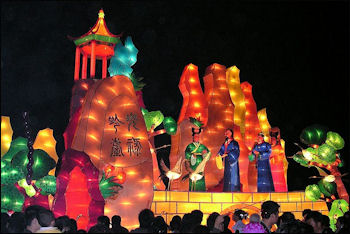
Hokchew Lantern Festival
Official national holidays are:
New Year’s Day (January 1 and 2)
Spring Festival or Lunar New Year (movable dates — three days — in January and February, 1st to the 3d day of the first moon of the lunar calendar)
Qingming (Tomb-Sweeping Day) in April
Labor Day, May Day (May 1)
Youth Day (May 4)
Dragon Boat Festival in May or June
Mid-Autumn Festival in September or October
National Day (two-day observance on October 1-2).
The dates of the Spring Festival, Qingming, Dragon Boat Festival and Mid-Autumn Festival are variable and determined by the lunar calendar. International Women’s Day (March 8), Youth Day (May 4), Children’s Day (June 1), Chinese Communist Party Founding Day (July 1), People's Army Day (August 1), and Teachers’ Day (September 10) are also celebrated but are not public holidays.
The largest festival of the year is New year or Spring Festival, whose date varies, falling between mid-January and mid-February. An occasion to honor one's ancestors. People clean their houses thoroughly to symbolize a new start, and children are given money in red envelopes for good luck. History enjoy special foods, fireworks and parades with dancers dressed as lions and dragons. [Source: Eleanor Stanford, “Countries and Their Cultures”, Gale Group Inc., 2001]
Eleanor Stanford wrote in “Countries and Their Cultures”: “Buddhist and Taoist temples hold special prayer gatherings to mark the full moon and the new moon. The birthday of Guanyin, the goddess of mercy, falls between late March and late April and is observed by visiting Taoist temples. The birthday of Mazu, the goddess of the sea (also known as Tianhou), is celebrated similarly. It falls in May or June. The Water-Splashing Festival is observed in Yunnan Province in mid-April. It involves symbolic bathing and water splashing that are supposed to wash away bad luck. The Zhuangs mark the end of the plowing season in the spring with a cattle-soul festival, which includes a sacrificial ceremony and offerings of food to the cattle. Moon Festival, or Mid-Autumn Festival, in September or October is celebrated with fireworks, paper lanterns, and moon gazing. The birthday of Confucius (28 September) is a time to make pilgrimages to his birthplace in Shandong Province.”
Websites and Sources: Wikipedia article on Chinese New Year; Wikipedia ; History of Chinese New Year history.com ; Chinese Calendar PaulNoll.com PaulNoll.com ; Wikipedia article on traditional holidays Wikipedia ; Wikipedia article on Chinese Calendar Wikipedia ; Chinese Astrology Chinatown Connection on Astrology Chinatown Connection ; Chinatown Connection on the Chinese Zodiac Chinatown Connection ; Wikipedia article on Chinese Astrology Wikipedia
Articles on Holidays and Festivals in this Website: CHINESE LUNAR CALENDAR AND CHINESE ACCOUNTING OF TIME factsanddetails.com; CHINESE HOLIDAYS factsanddetails.com ; TRADITIONAL FESTIVALS IN CHINA factsanddetails.com ; QINGMING (TOMB-SWEEPING DAY): HISTORY, PRACTICES AND BANS factsanddetails.com ; HUNGRY GHOST MONTH factsanddetails.com ; MID-AUTUMN FESTIVAL AND MOONCAKES factsanddetails.com ; CHINESE NEW YEAR: FAMILIES, FIREWORKS AND PHONES factsanddetails.com ; CHINESE NEW YEAR CUSTOMS, OBLIGATIONS, RITUALS AND FOOD factsanddetails.com ; CHINESE NEW YEAR FIXTURES: LONG TRIPS HOME, MIGRANT WORKERS AND PAYING DEBTS factsanddetails.com ; CHINESE NEW YEAR GALA TV SPECIAL factsanddetails.com ; factsanddetails.com ; LOSAR (TIBETAN NEW YEAR) factsanddetails.com ; TIBETAN RELIGIOUS FESTIVALS factsanddetails.com
January, February
New Year's Day — January 1st
Ice Festival — Late January to Early February — in Longqing Gorge, near Beijing, features an ice sculpture competition.
Tiancang Festival — February — is celebrated on the 20th day of the first lunar month. It is a harvest festival intended to produce good harvests the following autumn.
Harbin Ice and Snow Festival
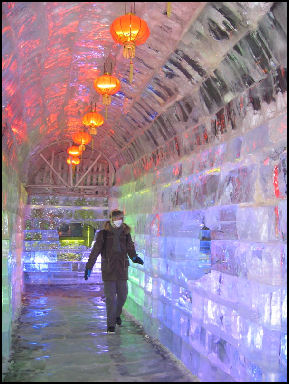
Ice Hallway Harbin Ice and Snow Festival — January 5th through Lunar New Year — is a month-long festival held in the freezing-cold. northeastern city of Harbin. One of China's most visually stimulating festival, it features ice sculptures with colored fluorescent lights frozen inside the blocks of ice. The Russians introduced the idea of ice sculptures, but it was a Chinese who came up with the idea of putting lights inside them. While the first festival dates to 1962 and the Harbin Ice Festival was only officially proclaimed in 1985, the idea of ice lanterns is said to date back to the Tang Dynasty.
The sculptures are made by carvers who take ice blocks from the frozen Songhua River, stick colored lights between the blocks, and shape ice-block masses into rocket ships, famous generals, lions, elephants, airplanes, acrobats, bridges, two-story pagodas, imaginary palaces, huge cars, platoons of soldiers, or famous structures like the Great Wall of China, the pyramids, the Taj Mahal, or the Eiffel tower. Sophisticated engineering and architectural techniques are used to build large 30- to 40-foot-high sculptures. The tallest one ever made was the 65-foot-high Lama Terrace; the largest was a model of Beijing's Hall of Prayer and Good Harvest, which was 40 feet high and 75 feet in diameter. Some of the works are quite abstract.
The largest and most impressive sculptures are in the People's Park. Some have ice bridges and ice staircases that people can walk on. These days ice sculpting teams from all over the world show up to show off their skills. Local students groups compete at Zhaoling Park. Sun Island, an island in the Songhua River on the outskirts of town, has its own exhibition. In 1999, Ice and Snow World opened up across the road.
Thousands of smaller ice sculptures, with names like Colorful Waves in Green Lake, Rainbow in the Sky, Dragon Boat Against the Wave and Enormous Wealth and High Rank, can be seen at 14 different viewing areas scattered around Harbin. The sculptures are impressive during the day but, obviously, they are best viewed at night when the colored lanterns are lit up. People come from all over China to see the sculptures, which usually remain standing until the snow melt in March or April. Five million visitors showed up in 2006 and injected millions of dollars into the local economy. The northern city of Shenyang also has a winter carnival with ice sculptures lit up by colored lights.
Chinese New Year
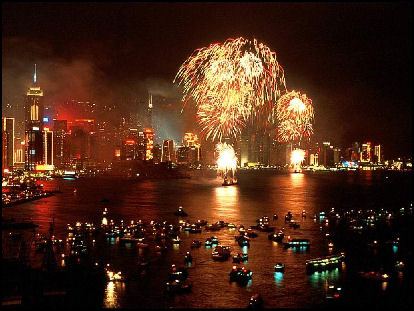
New Year in Hong Kong
Chinese New Year — Between January 20th and February 20th — is celebrated with spring cleaning, feasts, fireworks and family gatherings. Food is piled up to symbolize abundance; people dress in nice clothes; traditional cakes are distributed among family members; fruits, candies and ornamental packages of tea are given to friends as gifts. Firecrackers are set off to ward off evil spirits.
Chinese New Year is known in China as the Spring Festival and sometimes called the Lunar New Year in the West. It takes place on the first new moon of the first lunar month, which occurs after the sun enters the constellation of Aquarius. Indisputably China’s biggest holiday and the biggest of China's three "golden weeks," it is a time when most people take at least a week off from work and visit their home towns or take a trip. Everything is closed for at least three days — even stores that normally stay open for 24 hours. Before and afterwards the roads, trains, and airports are packed with people trying to get home and back.
Chinese New Year may fall between January 21 and February 19 and lasts for three days. Preparations generally begin in earnest two weeks in advance when streets are decorated with lanterns and streamers; shops sell paper money, drums and costumes; the number of street vendors increases; and parents buy firecrackers for their children. In the days before New Year charms are pinned on doors and gateposts to ward of evil spirits, houses are thoroughly cleaned, everything is decorated with the Chinese zodiac animal for that year; and people prepare themselves to paaaarrrty.
See Separate Articles CHINESE NEW YEAR: FAMILIES, FIREWORKS AND PHONES factsanddetails.com ; CHINESE NEW YEAR CUSTOMS, OBLIGATIONS, RITUALS AND FOOD factsanddetails.com ; CHINESE NEW YEAR FIXTURES: LONG TRIPS HOME, MIGRANT WORKERS AND PAYING DEBTS factsanddetails.com ; CHINESE NEW YEAR GALA TV SPECIAL factsanddetails.com
Tibetan New Year (Losar)
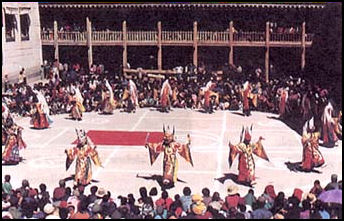 Tibetan New Year — February — is set according to the Tibetan calendar, and usually a couple weeks later than the Chinese New Year. The most important day on the Tibetan year, it is celebrated by Tibetans and Mongolians by tying prayer flags, cooking flour and butter on fires of smoldering evergreens, lighting lamps, making offerings, praying at shrines and monasteries, feasting on special dumplings, socializing, lighting purifying fires with fragrant smoke from juniper, artemisia and other herbs, gambling and drinking large quantities of chang. Celebrations often feature horse racing, lama dancing and offerings to gods.
Tibetan New Year — February — is set according to the Tibetan calendar, and usually a couple weeks later than the Chinese New Year. The most important day on the Tibetan year, it is celebrated by Tibetans and Mongolians by tying prayer flags, cooking flour and butter on fires of smoldering evergreens, lighting lamps, making offerings, praying at shrines and monasteries, feasting on special dumplings, socializing, lighting purifying fires with fragrant smoke from juniper, artemisia and other herbs, gambling and drinking large quantities of chang. Celebrations often feature horse racing, lama dancing and offerings to gods.
Tibetan New Year is known in Tibet as Losar, it is a festive and sacred three-day celebration in which Tibetans engage in rites to purify and renew the spirit and pay tribute to the Buddhist ideals of wisdom and compassion. Positive and negative actions taken during the holiday are believed to influence events in the coming year. Depending on a number of factors Tibetan New Year can fall as early as mid-January and as late as late March. Some years entire months are deleted from the Tibetan Year due to inauspicious alignments of planets and other factors. Usually it is celebrated in mid or late February.
Preparation for New Year begins a month in advance, when a special kind of barley is planted in little flower pots so that by the time New Year rolls around three-inch-high seedlings can be offered to Buddha. On New Year's Eve, a sorcerers dance is held to keep away nasty evil spirits; people put on new clothes and don grotesque masks; and boys go wild singing and dancing to music made by large drums and conch horns.
See Separate Article LOSAR (TIBETAN NEW YEAR) factsanddetails.com
Lantern Festival
Lantern Festival — Late February or Early March — is celebrated on the 15th day or 1st full moon of the 1st lunar month, two weeks after Chinese New Year, with lantern riddles, round sweet dumplings, dragon dances, lion dances, folk boat dances and trotting donkey dances. The first full moon of the New Year is regarded as the first day of spring. Dumplings symbolize family reunion and are a pun in Chinese because the character for "round" and "reunion" are the same. In the old days this holiday was celebrated with contemplation of the moon, the burning of stubble in the fields, and the consumption of a special liquors.
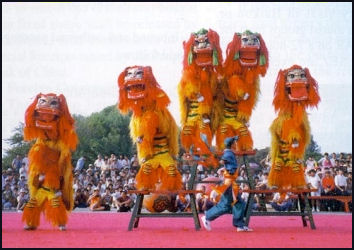
Lion dance
Lantern riddles are written on colorful lanterns. Rewards are offered to those who can solve them. In the old days the lantern were sometimes quite spectacular. Describing the festival at Hangzhou’s West Lake, the great 16th century historian Zhang Dai wrote that one could “enter the center of a lantern...into the fire, metamorphosed, not knowing of these were fireworks being setoff in the prince’s palace. Or if this were a prince’s palace composed of fireworks.”
Dragon dances feature huge dragons made of colored paper, cloth, and small battery-lit lanterns shaped like fishes and shrimp strung together with pieces of cloth. To the deafening sounds of gongs and drums the "dragon" dances up and down the streets while strings of firecrackers and fireworks are set off. There are special moves. It is important for dances to be well coordinated. There are professional dragon dancers and dragon dancing competitions.
In the lion dance, two dancers wear a lion costume which works a bit like the horse costumes used in old vaudeville routines. One dancer is the head and forelegs. The other dancer is the tail and hind legs. Together as the "lion" they performs feats like the "playing with water trick" and the "climbing the shed trick."
See Separate Article TRADITIONAL FESTIVALS IN CHINA factsanddetails.com
March, April
International Women’s Day — March 8th
Sandou Festival — Usually March — in Lijiang is a Naxi festival that honors a Naxi hero by sending candleit boats down the Old Town’s canals. It is held on the eighth day of the second lunar month.
Guanyin’s Birthday — March — is celebrated on the 19th day of the 2nd lunar month at Buddhist and Taoist temples all over China. It honors Bodhisattva Guanyin (the Goddess of Mercy), regarded as China’s favorite Buddhist deity.
Guanyin Fair — Late March or April — is a traditional festival celebrated on the 5th to 20th day of the 3rd lunar month at Taoist temples all over China that honors Guanyin (the Goddess of Mercy). The festival is a particularly big event in the Yunnan Province, where the Bai, Yi and Naxi people commemorate the arrival of Guanyin on Mount Cangshan and her victory of over the evil King Luocha. This fair attracts people from all over Yunnan. The Bai, Yi and Naxi people dress up in their beautiful ethnic costumes.
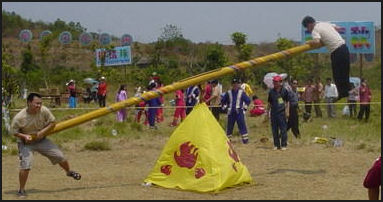
Zhuang Festival game
In Dali, there is a three-mile-long Grand Fair in which vendors line up on the main road and sell jade and silk products, strange musical instruments, gongs, and local crafts. In Lijiang, there is a livestock and medicinal market in which horses and oxen are sold along with Chinese medicines such as bear's gall bladder, fuzzy antler, Chinese caterpillar fungus and the root of the hairy Asia bell. Lantern shows and operas are also performed, and people watch horse races.
International Kite Festival — April 1st to 5th — in Weifang features kitefliers from all over the world showing off their kites. Over the years, the festival has featured a volleyball-court-size "King Kite," that required 80 young men and a blower to raise and ten ropes and a truck to keep in flight; the "Mother and Son Swallow" kite, one third the size of a match box; and the "Great Wall" kite, comprised of 200 accordion-like paper panels, with little wings for balance and 200 "passes" (the number of major passes on the real Great Wall). Kites have been flying in China for 2000 years and Weifang is the center of Chinese kite making and flying. In A.D. 956 a man flew a kite with a whistle attached to it. The whistle made a noise that sounded like "Weifang," and that purportedly is how the city got its name.
San Yue San
San Yue San — Late March, Early April — is three day festival celebrated on the 3rd day of the 3rd lunar month by the Li, Zhuang, Dong, Miao, Yao, She, Mulao and Geleo minorities in China's southern and central provinces. Sometimes called Venus Day, it is a time when boyfriends and girlfriends are chosen and villages celebrate the occasion with singing, dancing, archery, wrestling, playing on swings, tug of wars, pole climbing and other activities.
The Dong and Miao celebrate the first day of the festival by eating and drinking milky white wine. On the second day girls give baskets of shrimp and fish to the boys they fancy. On the third day everyone meets in the town square to participate in "drum treading" and "reed-pipe" dances.
On the night of the third day girls dress up in their most beautiful tribal costumes and go upstairs in their bamboo houses to sing to the boys who are waiting downstairs. Boys then follow the girls to the gate of the bamboo houses and sing their reply. For the Dong people this is the only time of the year they can sing in the village. The rest of the year they have to sing in a low voice up in the hills.
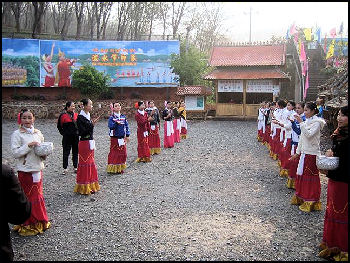
Dai courting dance
Boys and girls in the Li tribe sit opposite each other in two rows and sing songs of love to each other. If a boy and a girl fancy one another they exchange presents and get engaged. The Li also do a special dance called the Bamboo Game, in which bamboo poles are placed on the ground in the form of a grid, or checkerboard, and dancers nimbly dance from check to check without disturbing the poles.
On Hainan Island Li boys and girls engage in a tradition called "Romance in the Mountains," in which they stand opposite each other in two rows in a dense forest of rubber trees and sing in a strange style. Every time the singing stops the boys take one step forward. The process is repeated until the boy and girl meet, then they go off into the rubber tree forest together.
All of the minorities perform the Money Bell and Double Daggers Dance. In this dance one man holds two daggers in his hand. Another man holds a money bell. The man with the daggers tries to stab the man with the money bell, who in turn tries to run away.
Rocket Festival
Rocket Festival — Late March, Early April — is celebrated during the 3rd day of the 3rd lunar month by the Dong people of southern China. The "rocket" is a tea-cup-size iron ring — decorated with colorful silk threads symbolizing happiness — tied to an iron gun that launches the "rocket" into the sky about 30 meters.
Members of village teams, with 10 to 20 players, try to snatch the rocket and take it to a rostrum. The teams should have the same number of players. Sometimes two teams compete against one another. Other times three or more teams compete. Pushing , grabbing, blocking, passing the rocket and interception are all allowed. But hitting, kicking and using weapons are not allowed.
When the rocket is fired in a cloud of choking smoke, the players dash to where they think it might fall. All hell breaks loose. Eventually somebody emerges with the rocket and runs over to the rostrum. The winners of the two out of three series are awarded red stained eggs and glutinous rice cakes. Other activities at this event include Dong operas, bird competitions, shooting games and antiphonal singing.
Qingming (Tomb Sweeping Festival)
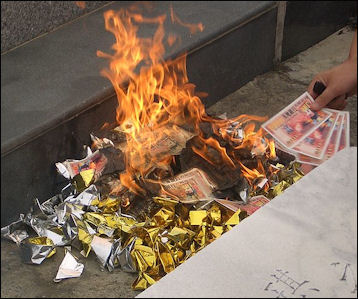
Tomb Sweeping Festival — April 4th and 5th — is a day when Chinese traditionally honor their dead ancestors by visiting their graves and tidying up and sweeping their family's tombs. Participants sometimes place flowers on the graves, burn ghost money, and make offerings of fruit, chicken, pork and sometimes beer. In rural areas, tombs are painted, grass is cut and the areas around the graves are swept clean. The holiday also marks the beginning of the busy agricultural season, when the fields are prepared and seeds are planted.
Tomb Sweeping is a recognized holiday in Taiwan and Hong Kong but not on the mainland which has traditionally tried to discourage ancestor worship. The dates of the festival, known in China as the Qingming Festival, of Day of Clear Brightness, are set by the solar calendar rather than by the lunar calendar. In recent years it has become popular to honor the dead online by clicking into “memorial halls” for the dead and lighting virtual candles and joss-sticks and sending flowers and messages. The government has encouraged the practice to reduce air pollution and waste caused by the burning of hell money and funerary objects
See Separate Article QINGMING (TOMB-SWEEPING DAY): HISTORY, PRACTICES AND BANS factsanddetails.com
Water Sprinkling Festival
Water Splashing Festival — 2nd or 3rd Week of April — is a wild three or four day event celebrated by the Dai people and other minorities in Yunnan Province. The Yunnan Stone Forest, Xishuangbanna, Gengma and Menglian are all good places to see it. Commemorating the day a beautiful young girl defeated the Evil King of Fire, the festival is celebrated with people tossing water all over one another. Buckets, basins and barrels are all used. Water can be splashed gently or thrown aggressively. Older people however should treated gently; water should only be sprinkled down the back of their necks
The festival also features dragon-boat races, peacock dances, pedestal drum dancing, courtship dances and “gaosheng” — launching. In the peacock dance, women wear brightly colored, eight-foot-long peacock feathers around their waists and twirl around. In the pedestal drum dance, a drum that looks like an elephant's leg is banged while dancers dance. In the courtship dances, young boys and girls stand in two lines opposite each other and throw small colored cloth bags at one another to express their love. Gaosheng are piece of bamboo filled with gun powder that are launched into the air.
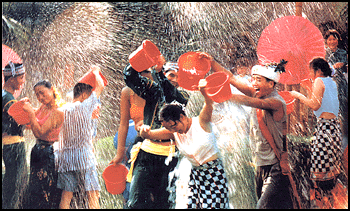
Water splashing festival
The Water-splashing Festival celebrates New Year on the Dai calendar. It is sometimes called Shanghan or Jingbimai (both variants meaning "New Year"), but it is more commonly called Hounan ("Water Splashing Festival") in the Dai language. The Water Splashing Festival is not only the first Buddhist festival of a new year, but also the most important festival observed by the Dai. It is called the Water-splashing Festival because during the festival days, people splash water on each other for good luck, a custom derived from cleaning Buddha statues. [Source: Chinatravel.com chinatravel.com \=/]
The Water-splashing Festival is celebrated in April (June by Dai calendar) every year, just before ploughing and rice seedling planting. People enjoy themselves and wish each other good luck, in order to send off the old year and welcome the new one, and to ask Sakyamuni (the Buddhia) and heaven gods to bring a good harvest and help people prosper. Similar festivals are big events in Thailand and Myanmar and among other Theravada Buddhist peoples. [Source: Liu Jun, Museum of Nationalities, Central University for Nationalities, kepu.net.cn ~]
May, June
Birthday of the Goddess of the Sea — Late April, Early May — is celebrated on the 23rd day of the 3rd lunar month in Fujian Province, Hong Kong, Guangdong, Taiwan and other Chinese coastal regions with parades of idols, lion dances, operas, and Taoist temple rituals. The festival honors the birthday of a sea goddess, who is known as Mazu in Fujian Province and Taiwan, and Tianhau in Hong Kong and Guangdong. In some places masked revelers dodge firecrackers while bearing replicas of the deity.
Labor Day — May 1st — It is now one of China's three "golden weeks" in which people take a week off from work and visit their home towns or take a trip. See Festivals
Youth Day — May 4th — commemorates a student demonstration in Beijing on May 4, 1919 held after the "rights" to Tianjin were handed over from Germany to Japan. The demonstrations gave birth to the nationalist “May Forth” Movement. It is marked in many places with large displays of flowers and is part of the May Day golden week.
Children's Day — June 1st — is often commemorated with youth field trips. Tourist sights are often swamped with school children around the time of this holiday.
Dragon Boat Festival

Dragon Boat Festival — Usually June — is held on the 5th day of the 5th lunar month. It honors the patriotic poet Qu Yuan, who drowned himself in 278 B.C. in the Milou River, with the eating of zongzi (traditional glutinous rice cakes wrapped in bamboo leaves) and dragon boat races. The largest and grandest boat races are held on the Milou River and Yueyang in Hunan and Leshan in Sichuan.
To honor Qu Tuan's death zongzi are wrapped in colorful silk are thrown into the river as an offering to the poet's spirit. The silk is used to keep away the flood dragon, who is afraid of silk. There are a number of rituals aimed at preventing floods. The festival tries to appease the god of the streams — the Dragon — so that rivers will not overflow their banks and cause floods.
The festival is celebrated all over the country, but in different ways. The Dai bang on their elephant leg drums and set off firecrackers. Korean women hold swing and seesaw competitions. In Guangxi there are men's and women's boating competitions in which no paddles are used (there is one race in which the participants use their hands and another in which they use their feet). At the end of each race in Leshan and in Zhangzhou and Xiamen in Fujian Province ducks are thrown into the water and the rowers jump in the water and try to catch them. The team and individuals that catches the most ducks get to keep them.
See Separate Article TRADITIONAL FESTIVALS IN CHINA factsanddetails.com
Huaer Festival
Huaer Festival — May, June or July — lasts for five days and is celebrated between the 4th and 6th lunar months by the Han, Hui, Tu, Sal, Dongxiang and Baoan peoples in the northwest provinces of Ningxia, Gansu and Qinghai. A huaer is a kind of folk song that is popular among these people. Most huaer songs are improvisations, sung by one or two people, with long and prolonged sonorous tones which have both a lyrical and a narrative content.
The festival is usually celebrated in a big square decorated with hanging red lanterns and colorful streamers. The festivities open with gongs, drums and fireworks. At night bonfires are built and sometimes the singing and dancing goes until dawn. In some places older singers put ropes around the festival site and people can't enter until after they have sung a song.
In the singing competition, which are held on a stage, singers are given a subject and they quickly have to compose a song about it. There are individual, duet and team competitions and participants are judged on their singing, their improvisations and their words. Sometime the singing is gentle and soft. Other times it is more forceful.
July, August
Founding of the Communist Party Day — July 1st
People's Liberation Army Day — August 1st — commemorates the founding of the PLA.
Lijiang Snow Mountain Music Festival — August — has been called “China’s Woodstock.” It features rock music, mud, and long-haired hippies covering themselves with body paint. Among those who have appeared are Cui Jian, Naxi musicians, some jazz rock groups and some pretty-boy hip hop artists. In 2002, about 10,000 people showed up for the two-day event.
Tibetan Festivals
Tibetan Festival — July — in Yushu in Qinghai Province lasts for five days and features dancing, folk performances, and horse racing.
Khampa Summer Festival — August — in Gyegu in Qinghai Province is one of the largest gathering of Tibetan people. Attracting Tibetans from all over western China, it features dancing, folk performances, horse racing. In recent years the Chinese government has tried to promote it as a tourism event.
Horse Festival — August — in Lithang in Sichuan Province is a large gathering of Tibetans. It features dancing, folk performances, and horse racing
Shoton Festival — August — at Drepung Monastery in Tibet is a seven day event that draws thousands of pilgrims, many of whom arrive on foot. They spin hand-held prayer wheels, recite Buddhist prayers, enjoy traditional dramas and unravel large silken images of Buddha on the hillsides. “Shoton” means “yoghurt.”
See Separate Articles: TIBETAN CALENDARS, FESTIVALS AND HORSE RACES factsanddetails.com ; LOSAR (TIBETAN NEW YEAR) factsanddetails.com ; TIBETAN RELIGIOUS FESTIVALS factsanddetails.com
Torch Festival
Torch Festival — July or August — is celebrated on the 24th day of 6th lunar month in southwest China by the Bai, Naxi and Yi people. Participants light torches in front of their houses and set 35-foot-high torches — made from pine and cypress timbers stuffed with smaller branches — in their village squares. The Bulang, Wa, Lisu, Lahu, Hani and Jinuo minorities hold similar festivals but on different dates.
The festival honors a woman who leaped into a fire rather than make love with a king. Before the village torch is lit people gather around it and drink rice wine. The village elders use a ladder to climb to the top of the torch as they distribute fruit and food to the villagers while they boisterously sing the "Torch Festival Song." The torch is then solemnly lit. The villagers light their torches off the village torch and sing and dance and eventually make their ways to their homes and light the torches there.
The Yi Torch festival. features courtship rituals, music, dancing around huge bonfires and bloodless bullfights. In the daytime, a ceremony is held to offer prayers to the gods or spirits associated with their lives. Prayers to earth God are made with chicken blood. After sunset, people light torches to send the gods backs. One Yi told Smithsonian magazine, “The celebration is all bustle and excitement. We slaughter goats and chickens, drink liquor, sing songs and dance, We also invite our best friends to a big feast.”
The Bai people in Dali practice a custom called "Splashing Fire for Blessing." When a person with a torch in his left hand encounters someone he points the torch at them, and sprinkles resin on the torch which produces sparks that are believed to keep away diseases and disaster. Other activities held during the torch festivals include bull against bull fights, wrestling and bonfire parties. The intent of the large bonfire is too keep evil spirits, harmful insects, diseases, and disasters away from the villages.
Nadam Fair
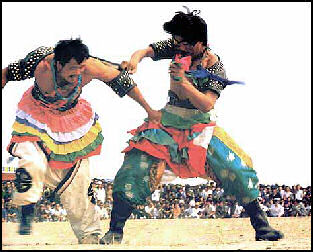
Nadam Fair — July or August — is a seven day fair held in Inner Mongolia. Nomads and herdsmen, as well as ordinary settled Mongolians, come from all over Inner Mongolia and set up their yurts on an empty grassland. Some come with oxen carts, some with camels, and some with Toyota Landcrusiers. Tea mixed with camel milk and fermented mare’s milk are prepared and everyone carries on and has a good time. The fairs in Hohhot and Baotou are open to tourists.
During the day there are all kinds of competitions: bulu, throwing, horse lassoing, Mongolian chess, balls games and martial arts. Mongolian tug of wars are interesting. Two competitors bend over and face away from each other with their butts sticking in the air. A rope is looped around the competitors' waists and they pull. The most popular events are traditional Mongolian wrestling matches, horse racing and archery. At night people sit around bonfires and watch dances and performances and listen to haolabao — a kind of story telling put to song.
Ghost Month
Ghost Month — August — or Hungry Ghost Month, begins on the full moon of the seventh month of the lunar calendar, usually around mid August, and lasts for 15 days to a month. It is a time when some Chinese believe spirits get a "summer vacation" from hell and return to the mortal world to cause mischief and enjoy feasts, performances of Chinese opera and other activities. Firecrackers are set off to scare away dangerous ghosts while ancestors are welcomed with bonfire offerings and recitations of Buddhist scripture.
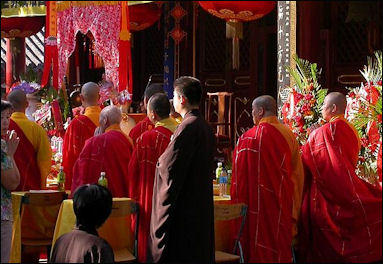
Buddhist Ghost Month procession Chinese go out of their to be nice to ghosts and go about their activities with more caution than usual. Many people avoid traveling, moving into new homes, opening businesses, or getting married because that ghost could cause mischief. People who die are sometimes stored and buried when Ghost Month is over.
Businessmen dread this time of the year because people are reluctant to buy anything; partiers stay home; wives orders their husbands to come home straight form work; and tourist stay away from beach resorts out of fear of being captured by ghosts in the water. The ghost month in 2006 was particularly nasty because it was a calender year with two seventh months, when the gates of hell open and the dead walk among the living twice.
Spirits are placated with kowtows (bows), prayers, offerings of chicken, pork, rice spirits and wine, and banquets and operas. Buddhists sutras are chanted to transfer merit to the dead and 2.5-meter candles are lit to honor them. After sunset many people make small fires and burn incense, paper televisions, paper Rolexes, paper cell phones, paper Mercedes Benzes and wads of “hell money” to appease the ghosts and encourage them to bring about good fortune. An old saying goes: "The bigger the flame, the better your luck will be."
he offerings and burnings can take place at the graves of ancestors but are usually directed towards “soul tablets” of the deceased in homes and temples. Buddhist monks and Taoist priests are hired to conduct special rituals to placate “hungry ghosts,” dead souls who have been condemned to a ghostly form for some misdeed they did and have huge bellies and small mouths. They are so named because they are perpetually hungry because they can never get enough to eat.
See Separate Article HUNGRY GHOST MONTH factsanddetails.com
September through December
International Confucius Conference — September — in Qingdao.
Confucius' Birthday — September 28th — is commemorated this day or the 27th day of 8th lunar month with offerings made at Confucian temples all over China. The largest observation of his birthday is held in Confucius's hometown of Qufu, in the Shandung Province, where, a 15 day celebration is held and people visit the Confucius Mansion, Confucius Temple and Confucius Woods and ride in ancient horse-drawn carriages through the town to Confucius's tomb, where an ancient Memorial service is reacted; and a special dance is performed by a 36-member folk troupe, using long feather wands and accompanied by a orchestra that plays solemn music on 20 different kinds of antique instruments. Rites are offered three times. Everything is done exactly as it was the first year after Confucius's death.
Tsingtao Beer Festival — Mid September to Early October — in Qingdao in eastern China lasts for 15 days and attract almost a million people. It features beauty contests and pop singer from China, Japan and South Korea and aims to "make visitors feel intoxicated."
Double Nine Festival — September or October — celebrates the auspicious number “9" on the 9th day of the 9th lunar month. It is regarded as a good time to drink lots of alcohol.
National Day — October 1st — celebrates the founding of the People's Republic of China in 1949. Traditionally celebrated with large military parades, it is now part of China's third "golden week," when people take a week off from work and visit their home towns or take a trip.
Beijing Jazz Festival — Mid November
Christmas — December 25th — is celebrated as a religious holiday among China’s small but growing Christian community and is increasingly becoming a commercial holiday among urban Chinese.
Mid Autumn Festival

moon cake
Mid Autumn Festival — Late September or Early October — is celebrated during the harvest moon (the first full moon of autumn) on the 15th day of the eighth lunar month in late September or early October. Also known as the "Reunion Festival" or “Mid-Autumn Festival, it is a time when families and friends get together and eat "Moon Cakes" as a symbol of reunion. Kids love the moon cakes, which are pies with sweet fillings. Moon cakes vary somewhat from region to region but usually have sweet been paste in the middle. The holiday is also celebrated with fireworks displays, the hanging of lanterns and the consumption of large amounts of maotai (rice liquor). It is now included in the third golden week of the year.
The moon cakes given as presents were traditionally filled with red bean paste and sold for a few pennies. These days you can get ones in fancy boxed sets with a layer of shark fin and edible gold images of Buddha imprinted on them for $25,000. Recipients are often corrupt officials. Other gifts given to corrupt officials at this time of year include dried abalone, platinum necklaces and golden chessboards.
Moon cakes, one story goes, played a pivotal role in the rebellion that ousted the Mongol Yuan Dynasty and launched the Ming Dynasty in the 14th century. The Mongols cracked down ruthlessly on the Chinese but failed to suppress the Chinese custom of exchanging little round full moon cakes during the coming of the full moon. Like fortune cookies, the cakes carried paper messages. The clever rebels used the innocent-looking cakes to give instructions to the Chinese population to rise up and massacre the Mongols at the time of the full moon in August 1368.
See Separate Article MID-AUTUMN FESTIVAL AND MOONCAKES factsanddetails.com
Muslim Holidays
Corban — 70 Days after Ramadan — is a Muslim festival celebrated in western China by Islamic ethnic groups like the Uyghurs and Hui. Also known as the "Livestock Sacrificing Festival," it commemorates the day that Abraham had a dream in which God told him to kill his son as an offering. Just as Abraham was about ready to do this, God intervened and told him to sacrifice a sheep instead.
Muslims begin Corban by washing themselves and visiting their local mosque. Later a sheep is sacrificed by slitting its throat. The animal is then skinned and carved up and eaten. Whatever is left over is given to the poor. The Tajik, Kazakh (Hasake), Uzbek and Keerkezi people like to celebrate this holiday with horse racing, sheep snatching and wrestling.

The Kazakh enjoy the "girl chasing game," in which a boy and a girl, both on horseback, enter a designated area, where the girl whips her horse and takes off with the boy in pursuit. Whatever jokes the boy makes and however mercilessly he teases her the girl must put up with it. On the way back, however, it is the girls turn to chase the boy. If she catches him she is allowed to hit the boy with her whip and he can't hit back. If the girl likes the boy she will just pretend to hit the boy. But if she doesn't like him she can hit the boy as hard as she wants. Traditionally, many Kazakh marriages begin this way.
In the "sheep snatching game" a sheep is placed in a designated area. Men on horseback ride to the area and try to grab the sheep, fighting off one another, and carry the sheep to another specified place. After its over the sheep is cooked into "Eating Happiness Mutton" and consumed.
Image Sources: Province maps from the Nolls China Web site. Photographs of places from 1) CNTO (China National Tourist Organization; 2) Nolls China Web site; 3) Perrochon photo site; 4) Beifan.com; 5) tourist and government offices linked with the place shown; 6) Mongabey.com; 7) University of Washington, Purdue University, Ohio State University; 8) UNESCO; 9) Wikipedia; 10) Julie Chao photo site; 11) Hong Kong and Taiwan governtment tourist offices; 12) China Trends; 13) Trip.com'; 14) Joho maps.
Text Sources: CNTO, New York Times, Washington Post, Los Angeles Times, Times of London, National Geographic, The New Yorker, Time, Newsweek, Reuters, AP, Lonely Planet Guides, Compton’s Encyclopedia and various books and other publications.
Updated September 2021
